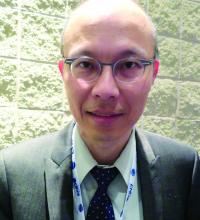LOS ANGELES – Kevin C.J. Yuen, MD, FRCP(UK), FACE, told colleagues at the annual scientific and clinical congress of the American Association of Clinical Endocrinologists (AACE).
“The data show that growth hormone replacement is safe and may improve survival,” said Dr Yuen, professor of medicine and medical director at Barrow Neurological Institute Pituitary Center in Phoenix.
Dr. Yuen is chair of the AACE’s growth hormone task force and coauthored both the 2009 and soon-to-be-published 2019 AACE guidelines for the treatment of adult growth hormone deficiency (AGHD).
Updated AGHD guidelines were needed for a variety of reasons, including a greater awareness of the benefits of hormone replacement in these patients and new developments in areas such as testing, he said. The guidelines also are also necessary because of the skepticism about the cost and benefits of AGHD therapy, concerns about the safety of long-term therapy, and the misuse of treatment in certain patients, he added.
On the treatment front, Dr. Yuen said it has become more clear over recent years that patients with AGHD benefit from hormone replacement. Findings from two studies have linked treatment to improvements in exercise capacity (Clin Endocrinol [Oxf]. 2016;85[4]:660-8) and patient quality of life (Eur J Endocrinol. 2017;176:99-109). “Even just after 6 months there’s an improvement in aerobic power,” he said.
And, he continued, other findings have suggested that treatment could lower mortality in men and reduce the number of deaths from malignant neoplasms in all patients (Eur J Endocrinol. 2017;176[1]:67-75).
However, Dr. Yuen cautioned that the confirmation of a survival benefit from hormone replacement will be speculative as long as there are no prospective data available.
He offered five tips about diagnosing and treating AGHD:
First, be aware that a number of conditions other than AGHD can cause low levels of insulin-like growth factor 1, including malnutrition, diabetes, untreated hypothyroidism, liver disease, and kidney failure.
Second, follow recommended algorithms for testing adult patients and transition those pediatric patients who seem to be at risk of having the condition. (Those moving from pediatric to adult care are known as transition patients.) The algorithms suggest that three diagnostic tests can be helpful, depending on the situation: the macimorelin test, the insulin tolerance test, and the glucagon stimulation test.
In 2017, the Food and Drug Administration approved the macimorelin (Macrilen) test, which requires the administration of an oral medication before a blood test. Dr. Yuen cited a phase 3 study that demonstrated that the test was “highly reproducible” and has a “good safety profile” (J Clin Endocrinol Metab. 2018;103[8]:3083-93). Dr. Yuen believes the test will become the preferred alternative to the insulin tolerance test.
Third, transition patients require special care as they move from pediatric care. “The handover is still very challenging,” Dr. Yuen said. “There’s still much to be done to improve the quality of treatment for these patients.” Challenges during the transition can include the patient’s reluctance to continue taking hormones in adulthood, he said. “Encourage pediatricians to start educating patients from early on that they’ll need to remain on hormones,” he advised, and help patients take accountability for their health in areas such as self-injection.
Patients may suffer from “injection fatigue,” they may be concerned about the side effects of the therapy, and/or they may be overwhelmed by the cost of care, he said. They may not understand how to manage their care and lack insight into the consequences of treatment cessation.
He advised endocrinologists to monitor transition patients who aren’t growth-hormone deficient because their status may change in the future.
Fourth, start treatment in adults with recommended doses of growth hormone. For those younger than 30 years, use 0.4-0.5 mg/day (higher for transition patients); for those aged between 30 and 60 years, use 0.2-0.3 mg/day; and for those who are older than 60 years, use 0.1-0.2 mg/day. Doses should be adjusted to 0.1-0.2 mg/day in patients with diabetes, obesity, and/or previous gestational diabetes.
Fifth, treat patients with growth hormone indefinitely if benefits are seen, but consider stopping treatment after a year if there doesn’t seem to be a benefit, Dr. Yuen advised. Follow up at 6 months, he recommended.
Dr. Yuen disclosed receiving research grants from and consulting for Pfizer, Novo Nordisk, and Aeterna Zentaris. He has also consulted for Strongbridge.

